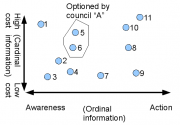Exploring decision-making options

To explore decision making options, we have to identify adaptation options. Some options may be gathered from experience such as project reports and conversations with other decision makers, or other options can be suggested theoretically. In other words, we cannot explore options which have not been experienced or discussed as potentially options. Any information might be useful to make decision, but the real question is how to explore multiple options selected by different analytical methods and studies. For example, if two relevant studies by cost-benefit analysis and multi-criteria analysis choose the different sets of adaptation options, a decision maker needs to know which options should be more appropriate. Therefore, we need some mechanism to explore potential adaptation options.
Example: Adapting to severe floods in Least Developing Countries

Figure 1: Example of mapping adaptation options.
We think a visual tool will be useful to make adaptation options comparable. Figure 1 shows an example of mapping potential adaptation options. The options are displayed in ordinal and cardinal scales, e.g. cost to adapt is cardinal measurement, but any scale from awareness to action will be ordinal scale. Let’s say this is about adaptation options for severe floods in the LDCs countries and a decision maker is from the Dakar city in Senegal and s/he pre-selects some existing adaptation options analyzed for this situation. In this situation, the option 8 can be a ‘flood defence’ and option 2 can be an ‘early warning system’. So, this mapping exercise gives some useful information, i.e. a flood defence is more expensive and more action oriented option than an early warning system. If this set of information is not good enough to choose adaptation options, the decision maker can explore additional information and adaptation options.
Exploring by methods

Figure 2: Exploring adaptation option by methods
The decision-maker may categorise these options by methods s/he is interested in (Figure 2). For example, the option 1, 2, 3, and 4 were identified by multi-criteria analysis as good adaptation options in previous studies. Similarly, the option 2, 4, 5, and 6 were selected by cost-benefit analysis and the options 4, 6, 7, 8, and 9 were selected by participatory action research. If there is an existing guidance, it will narrow down options the decision maker needs to look at.
Some guidance on the choice of methods is available, for instance from the EC Sustainability A-Test project[1] If it is the right stage in a project, participatory action research would focus on the options identified. Alternatively, if the decision-maker would like to select a most robust option, option 4 would be ‘best’ and option 10 and 11 would be ‘worst’ in this example.
Exploring by networking

Figure 3: Exploring adaptation options by social network
Alternatively, the decision maker may like to see what other people (city in this example) are doing. If s/he knows that a city like Chittagong in Bangladesh or Maputo in Mozambique has done something about adaptation to climate change and s/he always likes what that city does, why not just choose the same response? In this situation, the decision maker may put more weight on the option 5 and 6.
For more on Adaptation Decision Making please see the related initiative!
A list of methods for supporting adaptation decision-making
(0) Comments
There is no content